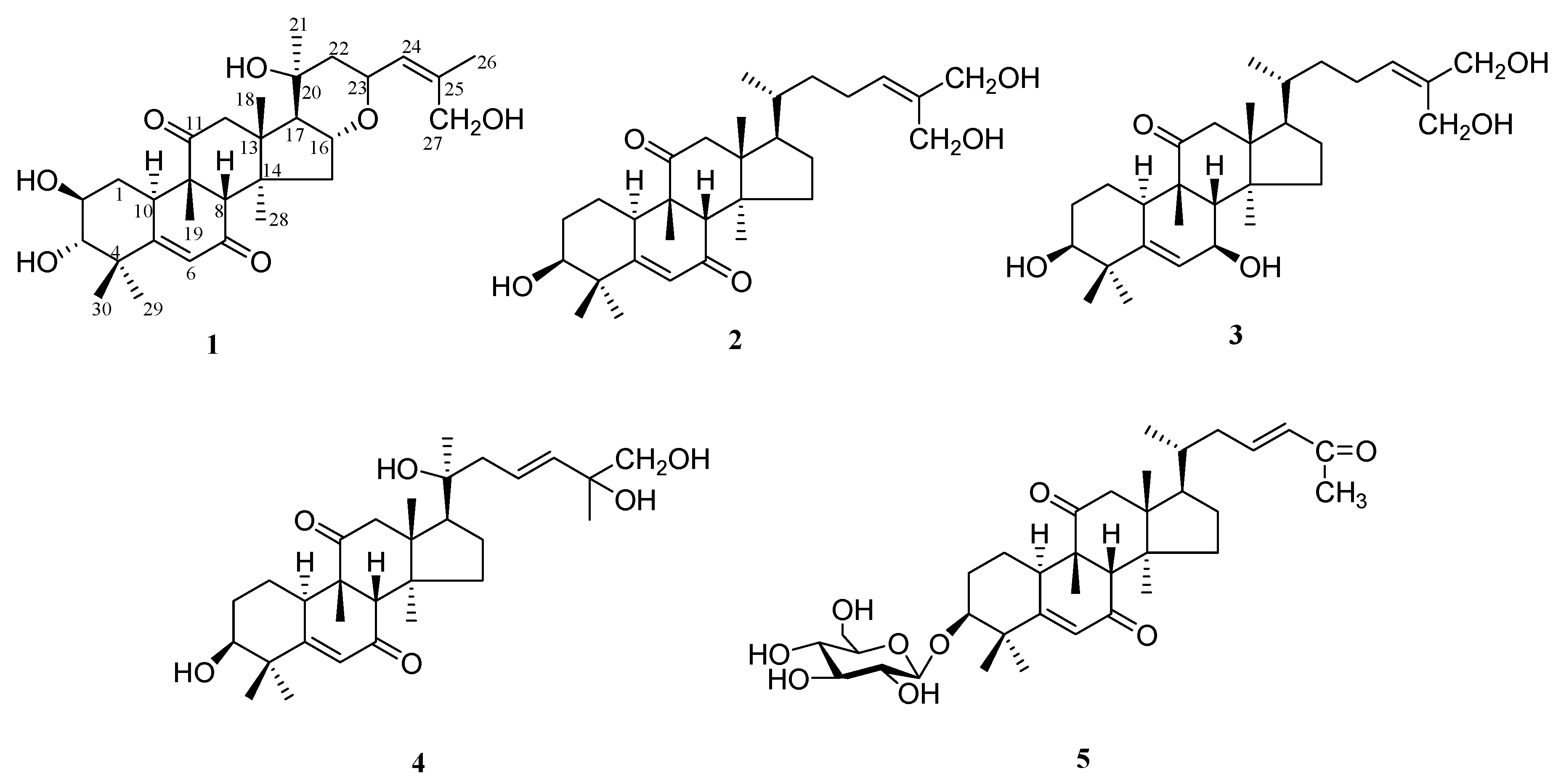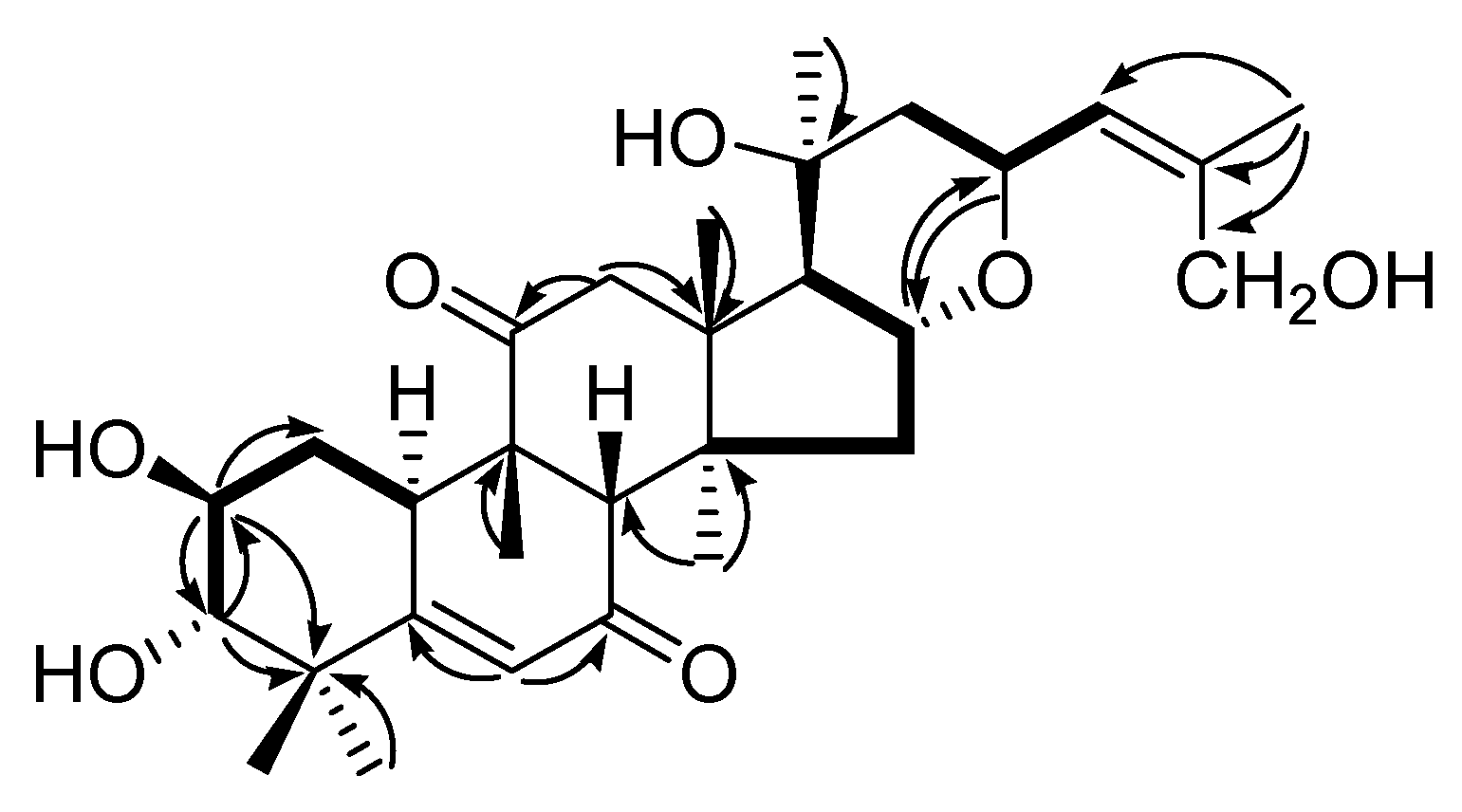Novel Cucurbitane Triterpenes from the Tubers of Hemsleya amabilis with Their Cytotoxic Acitivity
Abstract
:1. Introduction
2. Results
2.1. Structure Elucidation
2.2. Cytotoxic Activity
3. Discussion
4. Materials and Methods
4.1. General Experimental Procedures
4.2. Plant Material
4.3. Extraction and Isolation
4.4. Characterization of Compounds 1–5
4.5. Acid Hydrolysis of 5
4.6. Cytotoxic Bioassays
Supplementary Materials
Author Contributions
Funding
Conflicts of Interest
References
- Nie, R.L. The decadal progress of triterpene sapoins from cucurbitaceae. Acta Bot. Yunnan 1994, 16, 201–208. [Google Scholar]
- Li, Y.; Xu, X.T.; Zheng, Z.F.; Li, L.; Yao, Q.Q. Research progress on chemical constituents and biological activities of plants from Hemsleya Cogn. Chin. Tradit. Herb. Drug 2015, 46, 2800–2807. [Google Scholar]
- Meng, X.J.; Chen, Y.Z.; Nie, R.L.; Zhou, J. A new cucurbitacin from Hemsleya graciliflora. Acta Pharm. Sin. 1985, 20, 446–449. [Google Scholar]
- Li, P.; Zhu, N.; Hu, M.; Wu, H.; Tian, Y.; Wu, T.; Zhang, D.; Sun, Z.; Yang, J.; Ma, G.; et al. New cucurbitane triterpenoids with cytotoxic activities from Hemsleya penxianensis. Fitoterapia 2017, 120, 158–163. [Google Scholar] [CrossRef] [PubMed]
- Boykin, C.; Zhang, G.; Chen, Y.H.; Zhang, R.W.; Fan, X.E.; Yang, W.M. Cucurbitacin IIa: A novel class of anti-cancer drug inducing non-reversible actin aggregation and inhibiting surviving independent of JAK2/STAT3 phosphorylation. Br. J. Cancer 2011, 104, 781–789. [Google Scholar] [CrossRef] [PubMed]
- Nefedova, Y.; Nagaraj, S.A.; Rosenbauer, A.; Muro-Cacho, C.; Sebti, S.M.; Gabrilovich, D.I. Regulation of dendritic cell differentiation and antitumor immune response in cancer by pharmacologic-selective inhibition of the janus-activated kinase 2/signal transducers and activators of transcription 3 pathway. Cancer Res. 2005, 65, 9525–9535. [Google Scholar] [CrossRef] [PubMed]
- Sun, J.; Blaskovich, M.A.; Jove, R.; Livingston, S.K.; Coppola, D.; Sebti, S.M. Cucurbitacin Q: A selective STAT3 activation inhibitor with potent antitumor activity. Oncogene 2005, 24, 3236–3245. [Google Scholar] [CrossRef] [PubMed]
- Liu, T.Y.; Zhang, M.X.; Zhang, H.L.; Sun, C.Y.; Deng, Y.H. Inhibitory effects of cucurbitacin B on laryngeal squamous cell carcinoma. Eur. Arch. Otorhinolarygol. 2008, 10, 1225–1232. [Google Scholar] [CrossRef] [PubMed]
- Wu, J.; Wu, Y.J.; Yang, B.B. Anticancer activity of Hemsleya amabilis extract. Life Sci. 2002, 71, 2162–2170. [Google Scholar] [CrossRef]
- Fuller, R.W.; Cardellina, J.H.; Cragg, G.M.; Boyd, M.R. Cucurbitacins: Differential cyotoxicity, dereplication and first isolation from Gonystylus keithii. J. Nat. Prod. 1994, 57, 144–14452. [Google Scholar] [CrossRef]
- Xu, X.T.; Bai, H.; Zhou, L. Three new cucurbitane triterpenoids from Hemsleya pengxianensis and their cytotoxic activities. Bioorg. Med. Chem. Lett. 2014, 24, 2159–2162. [Google Scholar] [CrossRef] [PubMed]
- Li, Y.D.; Yi, S.R.; Sun, X.B.; Zhou, X.Y.; Zhang, H.Y.; Wang, Y.Q.; Yang, J.S.; Xu, X.D.; Ma, G.X. Bioactive cucurbitane triterpenoids from the tubers of Hemsleya penxianensis. Phytochem. Lett. 2016, 18, 5–9. [Google Scholar] [CrossRef]
- Kanchanapoom, T.; Kasai, R.; Yamasaki, K. Cucurbitane, hexanorcucurbitane and octanorcucurbitane glycosides from fruits of Trichosanthes tricuspidata. Phytochemistry 2002, 59, 215–228. [Google Scholar] [CrossRef]
- Zhao, G.T.; Liu, J.Q.; Deng, Y.Y.; Li, H.Z.; Chen, J.C.; Zhang, Z.R.; Zhou, L.; Qiu, M.H. Cucurbitane-type triterpenoids from the stems and leaves of Momordica charantia. Fitoterapia 2014, 95, 75–82. [Google Scholar] [CrossRef] [PubMed]
- Zhu, N.; Sun, Z.; Hu, M.; Li, Y.; Zhang, D.; Wu, H.; Tian, Y.; Li, P.; Yang, J.; Ma, G.; et al. Cucurbitane-type triterpenes from the tubers of Hemsleya penxianensis and their bioactive activity. Phytochemistry 2018, 147, 49–56. [Google Scholar] [CrossRef] [PubMed]
- Jiang, W.; Fei, Y.; Du, X.L.; Mu, Z.J.; Li, B.; Zhang, S.W.; Zhong, G.Y. Saxifraganoids A and B, two novel cucurbitane triterpenoid glycosides from Saxifraga umbellulata var. pectinata. Tetrahedron Lett. 2017, 58, 3541–3544. [Google Scholar] [CrossRef]
- Igile, G.; Oleszek, W.; Jurzysta, M. Vernoniosides D and E, two novel saponins from Vernonia amygdalina. J. Nat. Prod. 1995, 58, 1438–1443. [Google Scholar] [CrossRef]
- Liu, J.; Liu, Y.B.; Si, Y.K.; Yu, S.S.; Qu, J.; Xu, S.; Hu, Y.C.; Ma, S.G. New vernocuminosides from the stem barks of Vernonia cumingiana Benth. Steroids 2009, 74, 51–61. [Google Scholar] [CrossRef] [PubMed]
Sample Availability: Samples of the compounds 1–6 are available from the authors. |


| No. | 1 | 2 | 3 | 4 | 5 | |||||
|---|---|---|---|---|---|---|---|---|---|---|
| δC | δH (J in Hz) | δC | δH (J in Hz) | δC | δH (J in Hz) | δC | δH (J in Hz) | δC | δH (J in Hz) | |
| 1 | 34.2 | 2.65, m; 1.73, m | 21.7 | 2.28, m; 1.80, m | 21.8 | 1.74, m; 2.00, m | 21.7 | 2.29, m; 1.81, m | 22.5 | 2.08, m; 1.63, m |
| 2 | 70.5 | 4.14, td, 1.2, 8.4 | 29.6 | 1.87, m; 1.97, m | 30.3 | 1.22, m; 1.95, m | 29.6 | 2.10, m; 1.91, m | 28.6 | 1.87, m; 2.40, m |
| 3 | 80.8 | 3.52, d, 8.4 | 75.9 | 3.77, m | 76.0 | 3.78, m | 75.9 | 3.79, m | 87.2 | 3.71, m |
| 4 | 44.8 | 43.9 | 42.5 | 43.9 | 44.0 | |||||
| 5 | 168.3 | 169.2 | 145.1 | 169.3 | 168.4 | |||||
| 6 | 124.9 | 6.43, s | 125.8 | 6.47, s | 123.1 | 6.21, d, 9.0 | 125.8 | 6.47, s | 125.4 | 6.31, s |
| 7 | 200.3 | 199.6 | 66.5 | 4.42, dd, 9.0, 8.4 | 200.0 | 199.6 | ||||
| 8 | 58.8 | 2.81, s | 60.1 | 2.69, s | 54.4 | 2.50, d, 8.4 | 59.7 | 2.79, s | 60.0 | 2.63, s |
| 9 | 50.0 | 49.6 | 49.4 | 49.5 | 49.5 | |||||
| 10 | 36.6 | 3.25, m | 38.1 | 3.09, m | 36.5 | 2.64, m | 38.1 | 3.08, m | 38.0 | 2.99, m |
| 11 | 211.5 | 212.0 | 214.6 | 212.4 | 211.6 | |||||
| 12 | 49.6 | 2.88, d, 15.0 | 49.1 | 3.01, d, 15.0 2.59, d, 15.0 | 41.5 | 2.57, d, 14.4 2.96, d, 14.4 | 50.2 | 2.95, d, 14.4 2.77, d, 14.4 | 49.1 | 2.91, d, 15.0 2.51, d, 15.0 |
| 3.25, d, 15.0 | ||||||||||
| 13 | 49.3 | 49.0 | 48.7 | 50.0 | 49.0 | |||||
| 14 | 48.8 | 49.6 | 49.2 | 49.6 | 49.7 | |||||
| 15 | 42.0 | 1.73, m; 2.76, m | 35.3 | 1.38, m; 1.87, m | 34.9 | 2.02, m; 1.53, m | 35.2 | 2.08, m; 1.58, m | 35.3 | 1.45, m; 1.88, m |
| 16 | 70.9 | 5.17, m | 28.5 | 1.23, m; 1.85, m | 28.4 | 1.22, m; 1.81, m | 22.4 | 1.41, m; 1.96, m | 28.2 | 1.27, m; 1.85, m |
| 17 | 56.2 | 3.70, d, 5.4 | 49.6 | 1.62, m | 51.0 | 1.63, m | 50.7 | 2.23, m | 49.5 | 1.64, m |
| 18 | 20.5 | 1.26, s | 17.4 | 0.70, s | 17.3 | 0.76, s | 19.1 | 1.27, s | 17.4 | 0.71, s |
| 19 | 21.7 | 1.23, s | 21.1 | 1.29, s | 18.9 | 1.10, s | 19.8 | 1.30, s | 21.3 | 1.13, s |
| 20 | 72.7 | 36.3 | 1.32, m | 36.4 | 1.35, m | 74.5 | 36.4 | 1.33, m | ||
| 21 | 30.6 | 1.41, s | 18.8 | 0.83, d, 6.6 | 18.9 | 0.85, d | 27.8 | 1.46, s | 18.9 | 0.80, d |
| 22 | 46.9 | 2.02, m; 1.80, m | 40.0 | 1.18, m; 1.52, m | 35.0 | 1.21, m; 1.48, m | 49.5 | 2.55, m; 2.49, m | 40.0 | 1.81, m; 2.21, m |
| 23 | 70.8 | 5.10, m | 24.8 | 2.16, m; 2.30, m | 24.9 | 2.18, m; 2.36, m | 125.3 | 6.26, m | 147.2 | 6.84, m |
| 24 | 129.0 | 6.65, d, 6.6 | 127.7 | 5.90, t, 7.8 | 127.8 | 5.89, t, 7.2 | 139.9 | 6.06, d, 14.4 | 133.6 | 6.21, d, 15.6 |
| 25 | 139.3 | 141.4 | 141.3 | 73.7 | 198.2 | |||||
| 26 | 22.2 | 1.98, s | 65.7 | 4.71, s | 65.8 | 4.74, s | 71.5 | 3.93, m | ||
| 27 | 61.2 | 4.50, d, 12.6 | 58.8 | 4.74, s | 58.9 | 4.72, s | 26.1 | 1.64, s | 27.4 | 2.26, s |
| 4.57, d, 12.6 | ||||||||||
| 28 | 22.0 | 1.50, s | 19.0 | 1.10, s | 22.1 | 1.78, s | 28.4 | 1.22, s | 18.9 | 1.06, s |
| 29 | 23.4 | 1.36, s | 28.4 | 1.21, s | 27.8 | 1.18, s | 19.0 | 1.20, s | 28.6 | 1.20, s |
| 30 | 25.1 | 1.45, s | 26.1 | 1.44, s | 26.7 | 1.47, s | 26.0 | 1.45, s | 25.6 | 1.57, s |
| Glu-1 | 107.6 | 4.85, d, 7.8 | ||||||||
| 2 | 75.9 | 3.97, m | ||||||||
| 3 | 79.1 | 4.21, m | ||||||||
| 4 | 72.0 | 4.20, m | ||||||||
| 5 | 78.8 | 3.94, m | ||||||||
| 6 | 63.3 | 4.55, m; 4.39, m | ||||||||
| Compounds | IC50 (μM) | ||
|---|---|---|---|
| Hela | HCT-8 | HepG-2 | |
| 1 | 12.5 ± 0.56 a | 14.7 ± 1.2 | 13.4 ± 0.54 |
| 2 | 26.8 ± 1.1 | 5.9 ± 0.85 | 24.2 ± 2.2 |
| 3 | 22.3 ± 0.89 | 6.1 ± 0.26 | 28.6 ± 1.1 |
| 4 | 31.5 ± 0.74 | > 50 | 33.9 ± 2.0 |
| 5 | > 50 | 18.2 ± 1.3 | > 50 |
| Cisplatinb | 0.78 ± 0.02 | 0.65 ± 0.05 | 0.18 ± 0.01 |
© 2019 by the authors. Licensee MDPI, Basel, Switzerland. This article is an open access article distributed under the terms and conditions of the Creative Commons Attribution (CC BY) license (http://creativecommons.org/licenses/by/4.0/).
Share and Cite
Feng, W.; Zhou, Y.; Zhou, L.-Y.; Kang, L.-Y.; Wang, X.; Li, B.-L.; Li, Q.; Niu, L.-Y. Novel Cucurbitane Triterpenes from the Tubers of Hemsleya amabilis with Their Cytotoxic Acitivity. Molecules 2019, 24, 331. https://doi.org/10.3390/molecules24020331
Feng W, Zhou Y, Zhou L-Y, Kang L-Y, Wang X, Li B-L, Li Q, Niu L-Y. Novel Cucurbitane Triterpenes from the Tubers of Hemsleya amabilis with Their Cytotoxic Acitivity. Molecules. 2019; 24(2):331. https://doi.org/10.3390/molecules24020331
Chicago/Turabian StyleFeng, Wei, Yuan Zhou, Ling-Yu Zhou, Li-Ying Kang, Xiang Wang, Bao-Lin Li, Qing Li, and Li-Ying Niu. 2019. "Novel Cucurbitane Triterpenes from the Tubers of Hemsleya amabilis with Their Cytotoxic Acitivity" Molecules 24, no. 2: 331. https://doi.org/10.3390/molecules24020331
APA StyleFeng, W., Zhou, Y., Zhou, L.-Y., Kang, L.-Y., Wang, X., Li, B.-L., Li, Q., & Niu, L.-Y. (2019). Novel Cucurbitane Triterpenes from the Tubers of Hemsleya amabilis with Their Cytotoxic Acitivity. Molecules, 24(2), 331. https://doi.org/10.3390/molecules24020331






